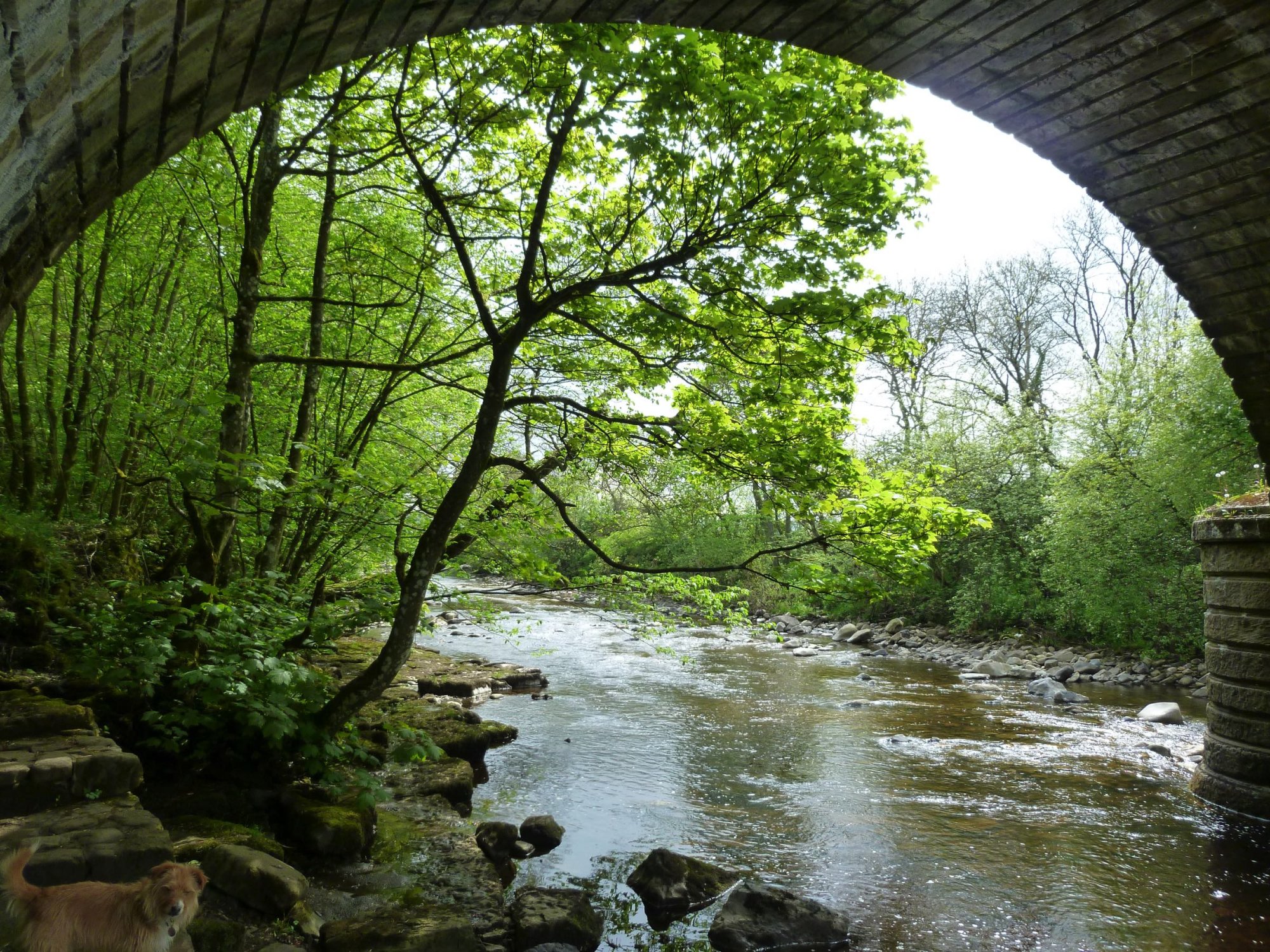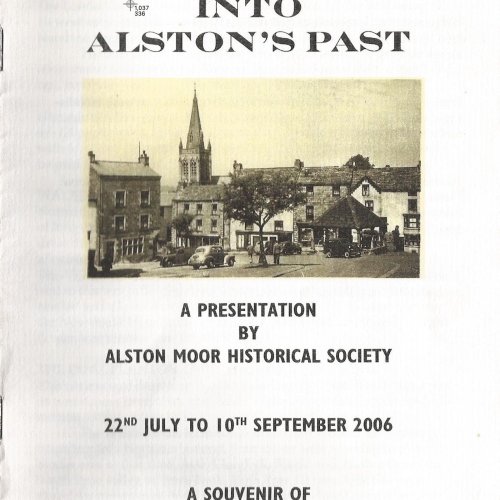BRIDGES, 1826-1839

The bridges which had been made more for packhorses than for carts, were in some cases unsafe and certainly did not match up to modern requirements. For example the bridge over the Tyne at Alston was described as “ill-formed and narrow”. Then the Justices of the Peace, at the County quarter sessions during the 1830s, began to order that certain bridges in the county be rebuilt or replaced, among them were the bridges of Alston Moor.
The first was the bridge at Gilderdale, which was a joint project between the counties of Cumberland and Northumberland. Cumberland was prompted into action after having been indicted at the Assizes in 1829 for not rebuilding the bridge. The justices immediately pleaded guilty, and ordered that £37.15s. should be put towards the building of a temporary bridge(!).
“Ordered: That this County do join the County of Northumberland in rebuilding Gilderdale Bridge, and that a plea of Guilty be put in to the Bill of Indictment preferred at the last Assizes against this County for not rebuilding the same, and that the sum of 37 15s 0d towards the building of a Temporary Bridge, be paid to the Revd. Benjamin Jackson, in order that he may pay it over when satisfied that the Work is done.”
At the Christmas Session on the 12th January 1830, it was “Ordered: That Gilderdale Burn Bridge, situate between this County, and the County of Northumberland, be built, and that this County be at one half of the expense thereof”.
Work on the new bridge started in the spring of 1830 and on 13th July 1830 at the Midsummer Session, there was a note to Robert Hodgson, Esq. the sum of £82 10s to be paid by him over to Joseph Teasdale, as the first instalment due upon his Contract for building Gildersdale Bridge, “so soon as Mr. Hodgson shall be satisfied that the Contract has been fulfilled”.
The work was finished in the autumn of 1831, at a total cost of £495, and at the Christmas Session on the 4th January1831 it was resolved, “To Mr. Joseph Teasdale, the sum of £82 10s, being the last instalment due to him from this County on his Contract for building Gilderdale Bridge”.
During this time, work had been done on the “Garry-gill Burn” bridge, when the sum of £49 was awarded to the contractor in October 1830. Then, in October 1831, “to the contractor for rebuilding Nenthall Bridge, the sum of £141.16s.10d., being the balance of such contract”, even though no previous mention of a contract appears.
 At the Easter sessions of 1833, the justices ordered that a new bridge be built at Alston, “on the site of or near the present bridge”. Conditions were that the Turnpike Trustees had to obtain the ground at their own expense and the contract price was not to exceed £1400. Work started the same year, but on 10th November 1833, the River South Tyne was badly affected by floods and the bridge under construction at Alston fell in.In December, the justices ordered that “the Bridgemaster cause Alston Old Bridge to be put into a state of repair sufficient to ensure its security till completion of the New Bridge; and that materials carried into the water by the recent floods be recovered and secured”.
At the Easter sessions of 1833, the justices ordered that a new bridge be built at Alston, “on the site of or near the present bridge”. Conditions were that the Turnpike Trustees had to obtain the ground at their own expense and the contract price was not to exceed £1400. Work started the same year, but on 10th November 1833, the River South Tyne was badly affected by floods and the bridge under construction at Alston fell in.In December, the justices ordered that “the Bridgemaster cause Alston Old Bridge to be put into a state of repair sufficient to ensure its security till completion of the New Bridge; and that materials carried into the water by the recent floods be recovered and secured”.
The incident must have had repercussions throughout the county, for the justices at their Midsummer Session on 1st July 1834, “Ordered: That in future, no County Bridge be ordered to be rebuilt, without previously having been examined and reported upon by the Bridgemaster”. In the autumn of 1834, £74 8s 9d was paid to Nixson and Denton “for getting stones out of the water at Alston bridge”.
For some reason in January 1835 the contract had to be re-tendered, but work was underway in the spring of that year, £200 being paid to the contractors as an initial instalment, with a further £100 on account of work carried out.
Construction proceded apace, with an understandable halt during winter months, after which regular payments were made, as well as further, presumably bonus, payments each time.
On 28th June 1836 the final payment of £159 15s 1d was made to the contractors, who remained nameless, and £10 was awarded to Timothy Welsh, owner of Bridge End Farm, for damages to his land and premises during the construction of the bridge. In the end the total cost of the bridge itself seems to have been £959.15s.1d.
The Bridgemaster, Mr. Milton, must have been good at his job of overseeing work on bridges in general, for in the Michaelmas session on the 18th October the justices ordered that his salary be increased to £450 per annum and that he was to have a permanent assistant.
The final entry for bridges on Alston Moor in this book of quarter sessions was on the 16th October 1838, for £50 to be paid to the Alston Turnpike Trust, for repairing the Nent Bridge (whether at Alston, Nenthall or Nenthead is not stated). Fryer and Hilton’s Map of 1775 shows the bridge over the Nent in Alston as being on the site of the present Foundry Bridge.
This information was taken from the record of the County Quarter Sessions held from 1836 to 1839. It is by no means the complete story of the bridges but it is interesting nevertheless.
MORE ABOUT THE BRIDGES OF ALSTON MOOR
The above article has been expanded slightly and it inspired further research into the bridges in the area, with the following results, mainly about the bridge over the Tyne at Alston.
A bridge was in existence at Alston in or before the 15th century. In the Black Book of the Augustian Priors at Hexham, compiled in the late 15th century during the reign of Henry VII (1485-1509), but referring to time immemorial before, two tenement boundaries are noted as abutting, “the old bridge or the site of the old bridge”, at Alston, but no location is give.
In the 18th century a brand new bridge was built at Alston. On 29th September 1758, a letter was sent from William Hewatson, Gent., to William Simpson, Clerk of the Peace concerning the release of a parcel of ground at the end of Alston Bridge, “the inhabitants have lately upon the petition and remonstrance of the said William Hewatson and great numbers of others, more particularly the inhabitants of Aldstone changed the situation of the old County Bridge at Aldstone from low grounds to Holford where a new Bridge is lately built at the public expence of the County. 2 yards by 100 yards, 5/-, part of Bridgend”. Where was “low grounds”? Presumably Holford is about where the present bridge stands. An old painting shows a single arch bridge adjacent to the Brewery. It is interesting to see, after a spate of the river has cleared the loose stones, that the river bed below the bridge is neatly paved with large rectangular stones.
The approach from the new bridge to the town was not complete and appears to have been something of an afterthought. On 1st October 1758, a letter was sent from John Reay to William Simpson, Clerk of the Peace about the lease for 600 years of a parcel of ground at the end of Alston Bridge, etc., including 5/- for “land lately part of a ffield or Enclosure called Newpark containing 300 yards more or less laid into and made use of part of the King’s highway leading from the New Bridge to the town of Aldstone”. There is also a yearly rent of one peppercorn to John Reay and his successors upon the Feast of St. Michael.
However, the new bridge did not last long. On 17th November 1771 The Great Flood of the River Tyne swept away all the bridges over the whole length of the river except the bridge at Corbridge. The flood was stated to have been six feet higher than that of 1763, which must have been another bad one.
The bridge built soon afterwards was mentioned in ‘Jollies Cumberland Guide and Directory’ of 1811 when it was noted, “The little town of Aldston stands on a rapid declivity on the eastern side of the Tyne, over which there is an old, narrow stone bridge of one arch”. Sixty years after its construction this bridge was the one described as “ill formed and narrow”.
There are a couple of notes of other bridges from much later in the nineteenth century. In the Sanitary Board minutes of the 4th May 1889, the Board noted that the bridge on the highway from Nenthall to Grassfield should be rebuilt, also the cost for work to the bridge at Galligill was estimated at £15.0s.0d.
Then in the newly formed Rural District Council Minutes of 30th March 1895, councillors heard that the Dorthergill Bridge at Tynehead needed rebuilt and noted “it is a very small bridge”.
Included with the Highways Inspector’s Report was, “Last year the bridge at Nentsbury was let down by the floods and was very much damaged. Had it not been secured by a large shaft-rope it is just possible that the bridge might have been carried away down the river. I have the offer of three heavy chains just adapted for holding bridges in their places at a small cost. I would recommend the Council to purchase them”. It was resolved that the chains be purchased. Changed days.
Thanks to Simon Danby for the two historical photos.

 Home
Home  Events
Events  Membership
Membership  Find Us
Find Us  About Us
About Us  Volunteer
Volunteer  Contact
Contact  Research Links
Research Links  Physical Archives
Physical Archives  Digital Archives
Digital Archives  1000 Year Lease
1000 Year Lease  Previous AMHS Websites
Previous AMHS Websites  Search
Search  Past Meetings
Past Meetings  Articles
Articles  Jubilee Exhibition
Jubilee Exhibition  Photo Gallery
Photo Gallery  Facebook Page
Facebook Page  Facebook Group
Facebook Group 












 Home
Home  Events
Events  Membership
Membership  Find Us
Find Us  About Us
About Us  Volunteer
Volunteer  Contact
Contact  Research Links
Research Links  Physical Archives
Physical Archives  Digital Archives
Digital Archives  1000 Year Lease
1000 Year Lease  Previous AMHS Websites
Previous AMHS Websites  Search
Search  Past Meetings
Past Meetings  Articles
Articles  Jubilee Exhibition
Jubilee Exhibition  Photo Gallery
Photo Gallery  Facebook Page
Facebook Page  Facebook Group
Facebook Group 
